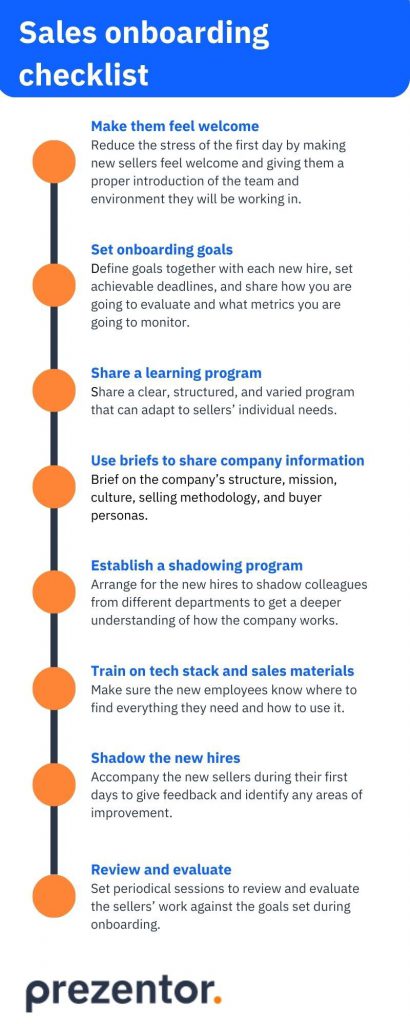Sales onboarding best practices
What is sales onboarding?
Sales onboarding is the process of training new sellers to give them the skills, knowledge, and tools necessary to become fully productive and meet their goals and quota. It is a crucial phase in an employee’s lifetime, as it shapes the perception of the new employer and company, and it contributes to the new hire’s level of engagement and retention. Yet, many companies still face a lot of challenges in this area.
In this article, we will talk about how to onboard new sales reps effectively and we will share a few best practices for sales onboarding.
The importance of effective sales onboarding.
According to the Sales Management Association, as much as 62% of companies consider themselves ineffective at onboarding new sales hires. Numbers don’t get any better if we look elsewhere – a study by Gallup found that only 12% of employees strongly agree that their organization does a great job onboarding new hires. Learning a few sales onboarding best practices is therefore an urgent necessity.
With effective sales onboarding, a company can:
- Get more value out of new hires more quickly. A carefully planned and well-structured onboarding program shortens the ramp-up time and makes new sellers fully productive sooner.
- Achieve consistency in the sales process. By following best practices and providing a structured, standardized learning program, a company ensures that all sellers get the same guidelines, thus increasing brand consistency and sales effectiveness.
- Improve customer experience. Well-prepared sellers understand the customers’ needs and challenges and can offer the best solutions, leading to increased customer satisfaction.
- Improve employee retention and engagement. Starting a new job can be stressful, so it is important that new employees feel supported and valued. A good onboarding process shows the company’s commitment to the sellers’ success and improves employee engagement and their likelihood to stay with the company for a long time.
7 Best practices for sales onboarding
1. Don't skip the introductions.
New job means new everything: new office, new colleagues, new tools, new practices, new goals… it can be a lot to adjust to, and it is normal for new employees to feel a little lost. Proper introductions between new hires and the rest of the team can help reduce this feeling. Explain what everyone’s role in the company is and who to go to for information or support on different matters. Giving a tour of the office and facilities will also help new employees to feel more comfortable in the new environment.
2. Set goals together.
Every seller is different in their way of working, so it is important to listen to each of them and set goals together according to their needs, while aligning with the company’s goals. Involving sellers in setting goals will also make them feel more invested and willing to achieve their objectives.
3. Define a learning program.
Each employee is also unique in their way of learning. Which is why a good learning program should be clear and well structured, but also adaptable to each seller’s needs and goals. To make learning more entertaining and memorable, the program should include several learning techniques and different types of learning materials, like written guides, checklists, videos, infographics, interactive elements, real-life scenarios and examples, etc.
4. Assign a mentor.
Select a person from your team – it can be a supervisor or a colleague – who has good experience and is willing to share their knowledge and give support. This way, the new seller will always have a point of reference to turn to in case of questions or if they need advice. Having a mentor can also help create a sense of belonging and increase the likelihood of the new hire staying with the company long-term.
5. Introduce job shadowing
Having the new hires shadow their colleagues can be a quick way for them to learn more about the company, its products or services, and its way of working. Don’t limit them to shadowing other sellers, let them have an inside look into how marketing campaigns get planned, what it’s like to work in Sales Operation, what’s going on in terms of product development, and anything else that might give them useful insights for their jobs.
6. Supply the right tools and materials.
Your new sales reps will need tools and materials to put their skills and knowledge into practice, as well as training on how to use them. Here are a few rules to follow:
- Make sure they get access to all the tools they need.
- Brief them on where to find sales content and how to use it.
- Collect all the content in one place, including learning materials and guides, so the new employees don’t waste time having to hunt for the right resources.
- Provide guides and checklists that help them quickly get used to any software they need in their daily jobs.
7. Provide a coaching program.
A seller’s training and development shouldn’t be over with the end of onboarding. It is important to establish a good coaching program to continue to follow your reps during their daily jobs and give them the support they need, exactly when they need it. Continued, personalized sales coaching can boost the productivity of sellers, improve employee retention, and lead to a better customer experience.
Sales onboarding checklist
We have put together a short checklist to follow, to ensure sales onboarding best practices get implemented successfully.
Make them feel welcome – reduce the stress of the first day by making new sellers feel welcome and giving them a proper introduction of the team and environment they will be working in.
Set onboarding goals – define goals together with each new hire, set achievable deadlines, and share how you are going to evaluate and what metrics you are going to monitor.
Share a learning program – share a clear, structured, and varied program that can adapt to sellers’ individual needs.
Brief on company’s structure, mission, culture, selling methodology, and buyer personas.
Establish a shadowing program – arrange for the new hires to shadow colleagues from different departments to get a deeper understanding of how the company works.
Give access and training on tech stack and sales materials – make sure the new employees know where to find everything they need and how to use it.
Shadow the new hires – accompany the new sellers during their first days to give feedback and identify any areas of improvement.
Review and evaluate – set periodical sessions to review and evaluate the sellers’ work against the goals set during onboarding.
Final thoughts
Effective sales onboarding brings obvious advantages both to the individual sellers and to the whole company. And it doesn’t have to be difficult to achieve – all it takes is some common sense and a few best practices. Make your new employees feel welcome and give them the material resources and human support they need, and you are well on your way to succeed.
Take your sales onboarding to the next level by investing in a sales enablement platform, like Prezentor, that allows you to manage the onboarding process with ease. Talk to one of our experts to find out more!


